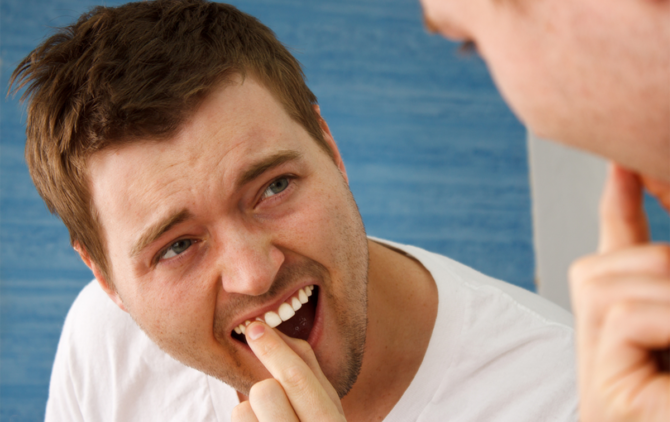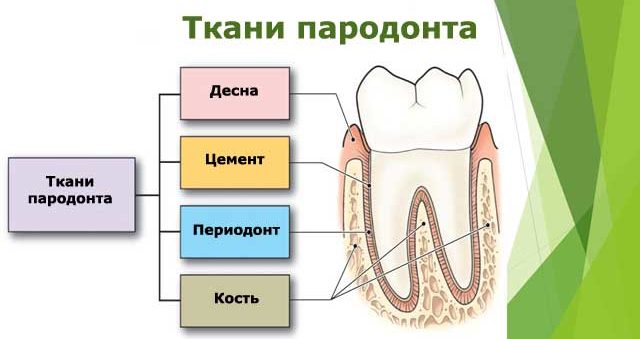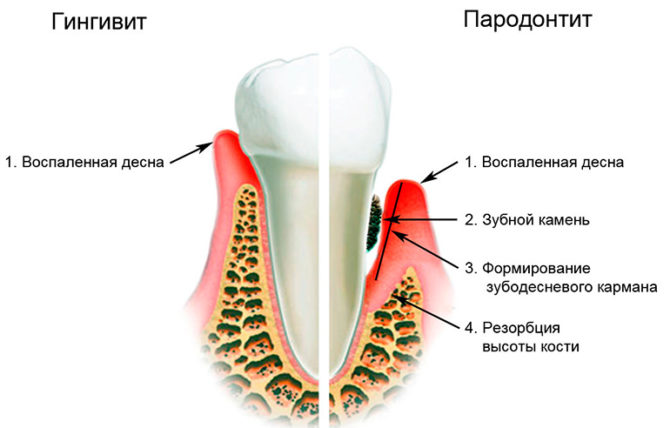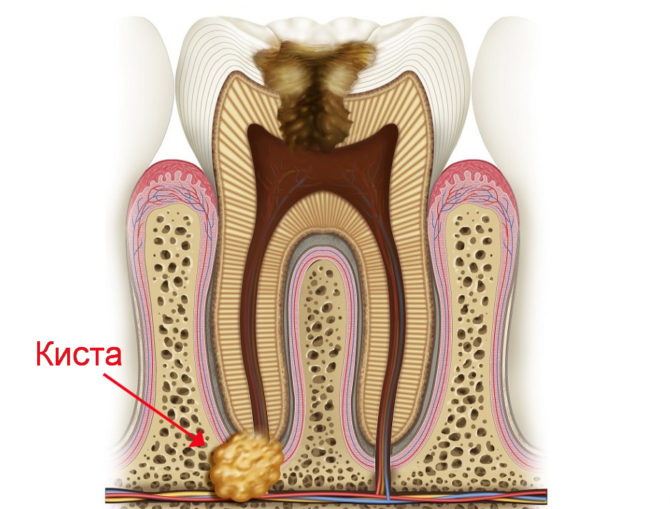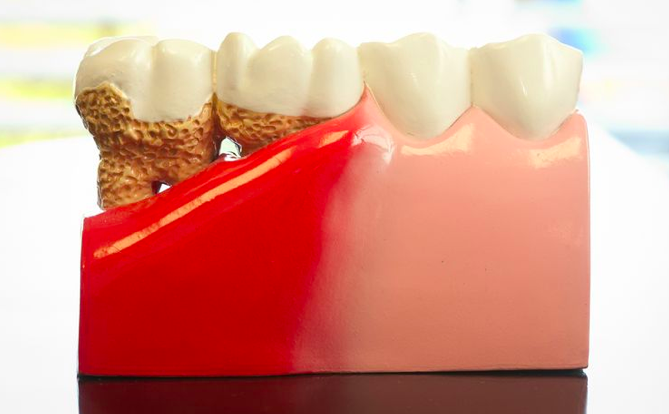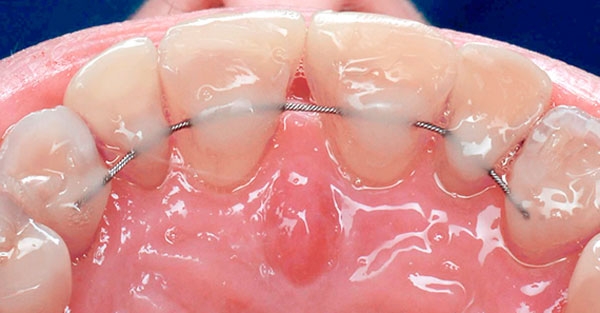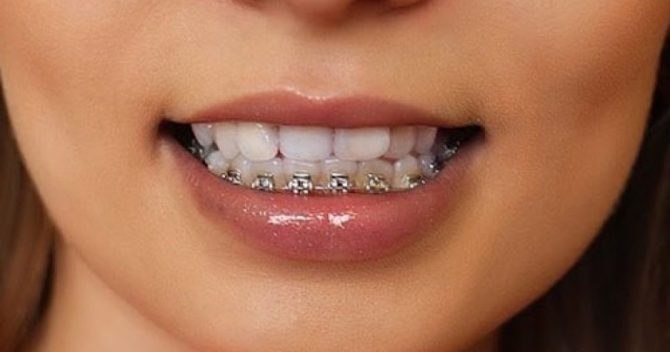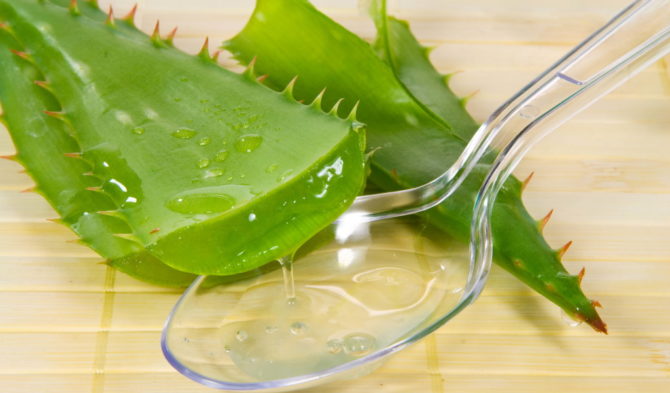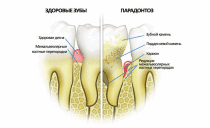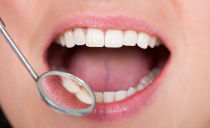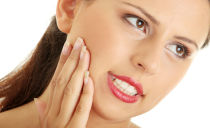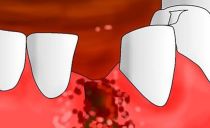How to strengthen the gums if molars stagger at home
If a person has loose teeth, he may try to strengthen the gums at home, but sooner or later he will still have to go to a dental clinic. The chances of solving the problem independently depend on the reason why the teeth began to stagger, and on the degree of development of the pathology. But only the dentist knows how to eliminate all the negative factors that cause tooth decay.
Content
What causes tooth mobility
Healthy teeth do not swing, since their roots are attached to the jaw with the help of a whole complex of various tissues - periodontal, which is responsible for maintaining the stability of the dentition.
Periodontal components and their functions:
- The mobility of the teeth is limited by the holes formed by the alveolar processes of the jaw.
- A special tissue - cement - covers the tooth roots and fixes them in the holes.
- The periodontal ligament firmly fixes the tooth in the jaw.
- Gum muscles tightly cover the base of the dental crowns, so they do not hang out.
Mobility of the dentition can cause pathology that develops in any part of the periodontium. Its destruction occurs for various reasons: both due to the influence of bad habits, and due to systemic diseases of the body. It is definitely possible to say why teeth are loose, only after a professional examination of the oral cavity.
Dental diseases
In the field of dentistry, several diseases are distinguished in which teeth sway:
- Gingivitis - The primary inflammatory process on the gum, which is manifested by its redness and bleeding. Teeth with gingivitis do not loosen and can be saved at home. If untreated, gingivitis will develop and become periodontitis - inflammation of all tissues surrounding the root of the tooth. Due to the total destruction of the periodontium, pain occurs in the problem area, the crown loosens.
- Cyst - A neoplasm in the basal region of the tooth filled with fluid. A large cyst can put pressure on adjacent tissues, causing the staggering of healthy teeth. It is impossible to detect and cure the formation at home, it is determined using x-rays and removed surgically in the dentistry office.
- Granuloma - purulent complication in a greatly expanded cyst. The infection covers the gum and all periodontal tissues, the affected tooth is very sore, its staggering increases. The problem is solved by surgery and antibiotic treatment, a movable tooth usually falls out.
- Periodontal disease - general depletion of tissues responsible for tooth stability. The disease does not cause inflammatory processes, develops imperceptibly and gradually - over 10-12 years. With the early development of pathology, the symptoms are poorly expressed, in the second stage the teeth become mobile, the gums become thinner, a dense stone appears on the exposed tooth necks. Then the loosening of the teeth becomes maximum, and they begin to fall out. It is impossible to independently establish why periodontal disease develops, since in most cases it is provoked by systemic diseases in which the blood supply to the tissues of the oral cavity is disturbed.
What internal diseases make your teeth loose
Often, dental diseases provoke systemic pathologies, accompanied by hormonal disorders or metabolic disorders:
- Endocrine diseases lead to osteoporosis of the bones, as a result, weak jaws cannot ensure tooth stability.
- Circulatory disorders in periodontal tissues may be due to diabetes.
- Osteoporosis reduces the strength of the jaw bones and causes inflammation in the oral cavity.
- Psoriasis with complications in the form of diabetes and arthritis also often causes staggering and tooth loss.
- Unsustainable nutrition, in which an insufficient amount of vitamins and minerals enters the body (A, B, C, D3, calcium, fluorine, phosphorus), leads to frequent inflammation and depletion of all periodontal tissues, due to which the dental crowns become mobile. Such a cause of loose teeth is often detected in pregnant women, when an actively growing fetus takes calcium and phosphorus from the mother's body.
- Bruxism is the grinding of teeth. In an adult, such a habit causes loosening of the teeth. In a child, it can provoke the development of a malocclusion and subsequent instability of the dentition. Often babies begin to grit their teeth during weaning from the nipples, in adolescents bruxism appears as a result of overwork. Only a dentist is able to establish the presence of a malocclusion, he is also competent in ways to get rid of night rattle.
Since the reasons why teeth are loose are very diverse, it is not worth treating the pathology at home. It is better to visit a specialist who can determine the specific cause of loosening and choose the best way to eliminate it.
Is it possible to save a tooth that is loose
To determine whether salvation of a staggering tooth is possible, only a qualified doctor can. After examination, he will establish the cause of his mobility and prescribe treatment or removal.
If your front teeth are loose
If the crown of the front tooth staggers after an injury, it must be strengthened with splinting. So that the problematic incisor does not fall out, it is attached to adjacent healthy crowns using a special orthopedic prosthesis.
If the lower or upper front teeth are loose for other reasons, you can do the following:
- If bad habits (smoking, careless treatment of the oral cavity) lead to pathology, you can try to strengthen the gums with the help of medical pastes. For an adult, pastes such as Paradontax, Splat, Lacalul active are suitable, for a child - Weleda. The brush used for brushing your teeth should be marked Soft.
- Launched periodontitis is treated with the help of a range of dental measures. First, the dentist will clean the enamel from plaque and stone, then prescribe hardware procedures, antiseptics and anti-inflammatory drugs: Furacilin, Rotokan, Rekutan, Vokara.
- In the treatment of periodontal disease, a biological complex of proteins and synthetic bone material - Straumann ® Emdogain ™ can be used. It restores the structure of periodontal tissues, helps to strengthen the moving incisor.
If the lower incisors are staggering due to malocclusion, they are strengthened by orthodontic therapy. Braces, plates and other devices contribute to an even distribution of chewing load and correction of the bite.
Strengthening the molars
Treatment options for “swinging” molars:
- Often, molars of adults stagger due to the absence of a neighboring molar. In such a situation, you need to resort to prosthetics.
- The mobility of molars occurs when cysts and granulomas form. In such cases, surgical intervention is used: growths are removed together with the affected part of the root and crown. The modern method - depophoresis - allows you to do without surgery. Having drilled one channel in a sick crown, the doctor introduces a special fluid into it and act on it with an electric current.This procedure is detrimental to microbes that have affected the root canals. After removal of the infection that caused tooth mobility, drug treatment is carried out:
- Rinses relieve inflammation, kill bacteria (Chlorhexidine, Lacalyut fresh, Colgate crybaby).
- Medicines in the form of balms, gels, ointments stimulate blood flow in the gums, when they are used, it hurts less, heals faster (Forest Balsam, Asepta gels, Holisal, Solcoseryl ointment).
- Trental medicine in the form of tablets helps to restore metabolism in the affected tissues of the oral cavity, quickly remove their inflammation.
What you need to do if the molar staggers in a child depends on the age of the baby:
- From six to twelve years old, children have replaced primary teeth with permanent teeth. At this time, staggering of the dentition is a normal physiological process: the old crown leaves the hole and makes room for a new tooth. If it lingers in the hole for a long time, it is recommended to carefully remove it yourself - otherwise a new tooth may grow curved.
- When a baby tooth hurts and staggers, a doctor’s help is needed to help preserve it. Due to the early loss of milk incisors and molars, permanent crowns in their place will grow twisted and infected.
The fragility of permanent molars in adolescents over 12 years of age occurs due to injury, with periodontal inflammation or systemic diseases. In such cases, a staggering tooth can be strengthened only with the help of a dentist, without examination and recommendations treatment will be ineffective.
How to strengthen teeth and loose gums folk remedies
Strengthening gums and loose teeth with folk remedies should complement professional therapy, the only way to completely get rid of the factors that cause pathology.
Homemade Toothpastes
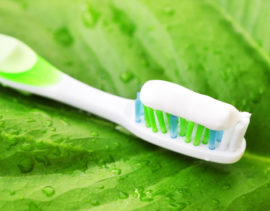 It is recommended to switch to therapeutic toothpastes, which you can do yourself:
It is recommended to switch to therapeutic toothpastes, which you can do yourself:
- Mix tooth powder and calamus root in equal proportions.
- Make a paste of 100 ml of warm water, 3 g of baking soda, the same amount of salt and white clay.
- Prepare a mixture of wood ash, soda and salt in equal proportions.
Rinse aid
To strengthen and disinfect gums, you can rinse your mouth with pharmacy antiseptic agents, tinctures and decoctions of medicinal herbs.
Tinctures
- Propolis. Combine two liters of alcohol (30%) or vodka, a handful of propolis, 100 g of calamus root, a pinch of mint. Insist the mixture for a month and rinse her mouth after eating for 2-3 weeks.
- Celandine. Mix celandine juice with alcohol in equal parts. Dilute 1 teaspoon in a glass of water. concentrated tinctures and use the remedy throughout the day. It can be used for a long time.
Decoctions and infusions
- Chamomile. Two tablespoons of flowers pour boiling water (200 ml), insist for an hour and rinse with a mixture of mouth for 2-3 weeks. The tool is effective for healing wounds and relieving inflammation.
- Oak bark. In 0.5 l of water, pour 3 tbsp. l raw materials, bring the broth to a boil and wait until it cools. Rinse your mouth three times a day to get rid of bleeding gums.
 Aloe. Finely chop two large sheets, add 1.5 cups of water, boil. Rinse your mouth with a cooled broth after a meal to destroy pathogens and relieve inflammation in your mouth.
Aloe. Finely chop two large sheets, add 1.5 cups of water, boil. Rinse your mouth with a cooled broth after a meal to destroy pathogens and relieve inflammation in your mouth.- Mint and sage. It is necessary to take 20 g (1 tbsp. L.) Of mint and sage, pour boiling water, insist for half an hour. Rinse the gums in the morning and evening to strengthen them and improve blood circulation.
- Tea tree oil. In half a glass of warm water add 2-3 drops of essential oil and mix. The mixture is used to relieve inflammation and heal wounds.
- Horseradish. Add horseradish juice (2 tsp) to a glass of wine and rinse your mouth with it throughout the day.
- Soda and iodine. This composition imitates sea salt, it is prepared as follows: add 3 drops of iodine and a half teaspoon of salt to a glass of water. Rinse the mixture with the oral cavity after each meal.
Rubbing gums and lotions
If your teeth are loose due to gum disease, you can strengthen them with the help of proven folk remedies designed for rubbing and lotions:
- Sea salt and honey. Add 1 tsp. salt in 2 tsp honey and rub gums daily with the mixture.
- Soda, hydrogen peroxide, lemon. Take a teaspoon of soda, lemon or lime juice, add 8 drops of peroxide, mix and rub the problem gums.
- Garlic. Regular rubbing of the gums with garlic effectively disinfects the oral cavity, the product can be used only if there are no ulcers and wounds on the gums.
- Lotions of fir oil. Mix 10 drops of any vegetable oil with 5 drops of fir essential oil, soak with a cotton swab and apply it to the sore gums for 15 minutes. The procedure is carried out for a month - during this time bleeding is eliminated, periodontal tissues are strengthened.
- Lingonberry juice. It relieves inflammation and eliminates tooth instability, use juice as lotions.
Aloe leaf can be applied to problem gums, it well disinfects foci of inflammation, prevents staggering of the dentition.
Massage and gymnastics to preserve teeth
Regular gum massage improves blood circulation, serves as a prevention of periodontal disease. The procedure should be carried out for 5 minutes a day for 14 days, then you need to take a two-week break, after which you can resume the treatment course.
- Massage technique. First exercise: moisten the index finger and thumb with tea tree oil (sea buckthorn, fir, eucalyptus) and stroke their gums near each crown on the outside and inside. The second exercise: squeeze the gums in the direction from the edges of the jaw to the center. The third exercise: rub the gingival tissue around the dentition, moving from the center to the edges. After massage, rinse your mouth with any antiseptic.
- Gymnastics for teeth. It implies biting, chewing of young branches of rose hips, currants or apple trees.
- Therapeutic gum. A homemade chewing gum made of wax (100 g) and honey (50 g) has a good healing effect: you need to melt the ingredients, add 3 drops of peppermint oil, make balls from the mixture and chew them every day.
Careful oral care, regular visits to the dentist, prevention of periodontal diseases with home remedies - all these measures will help to keep your teeth healthy and stable.

